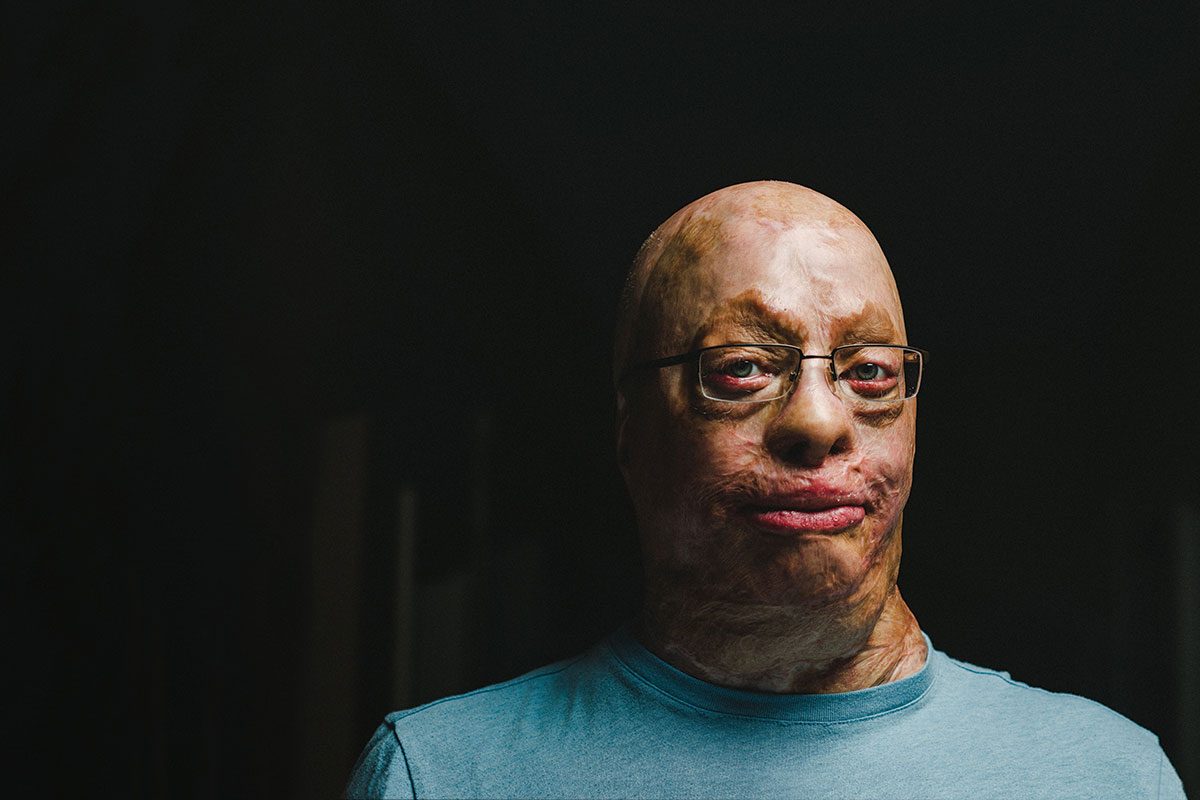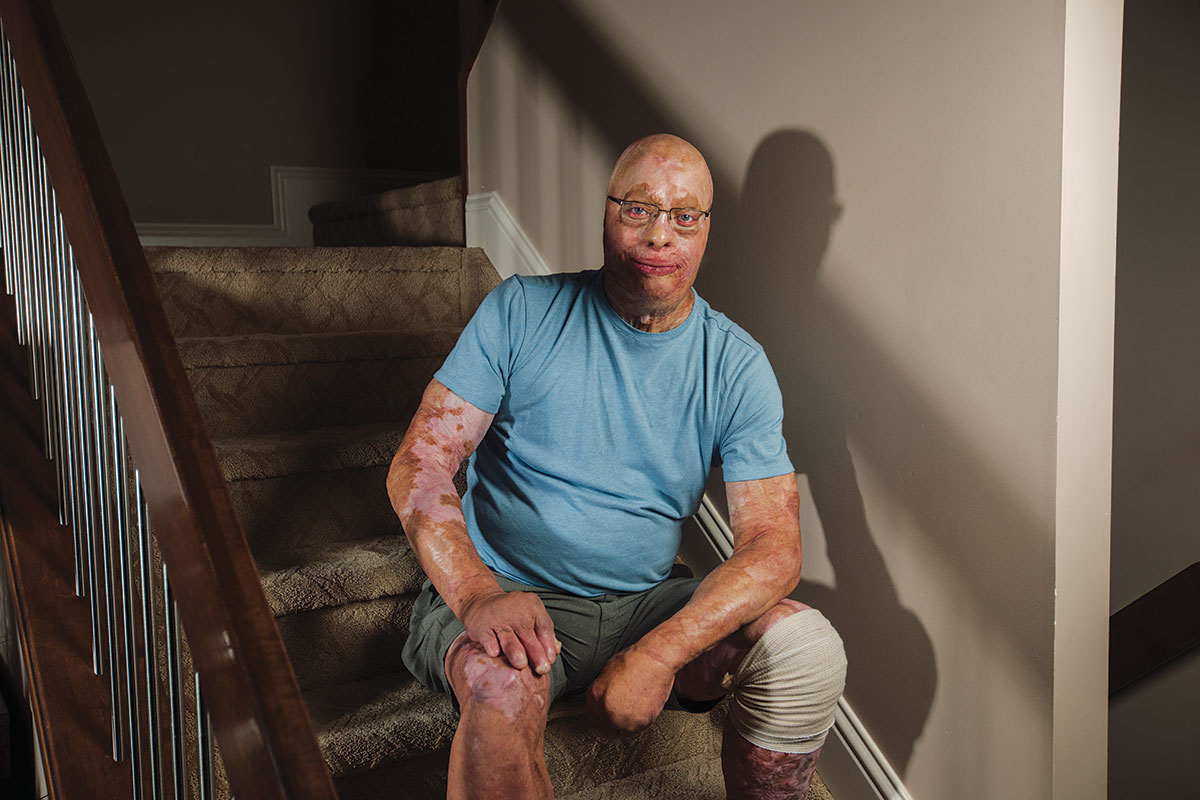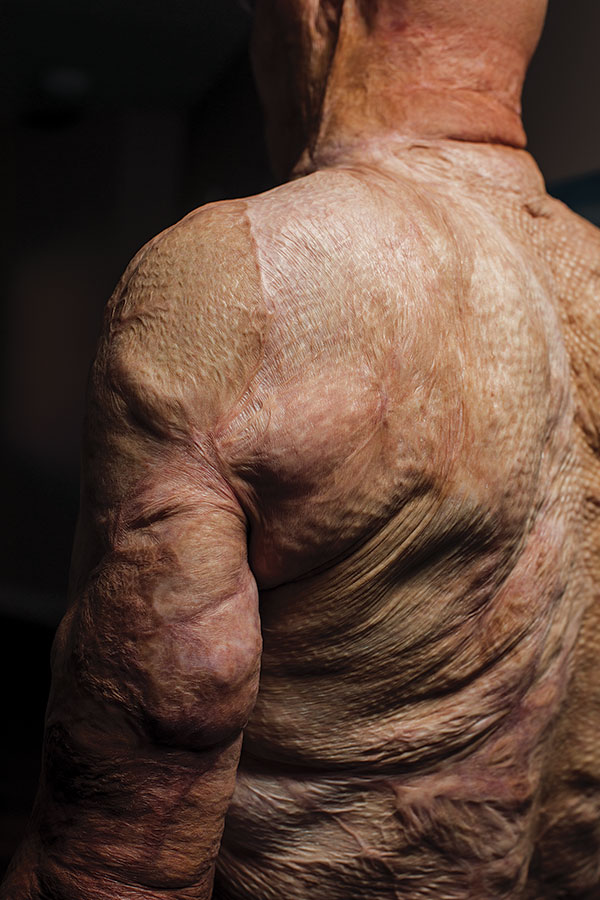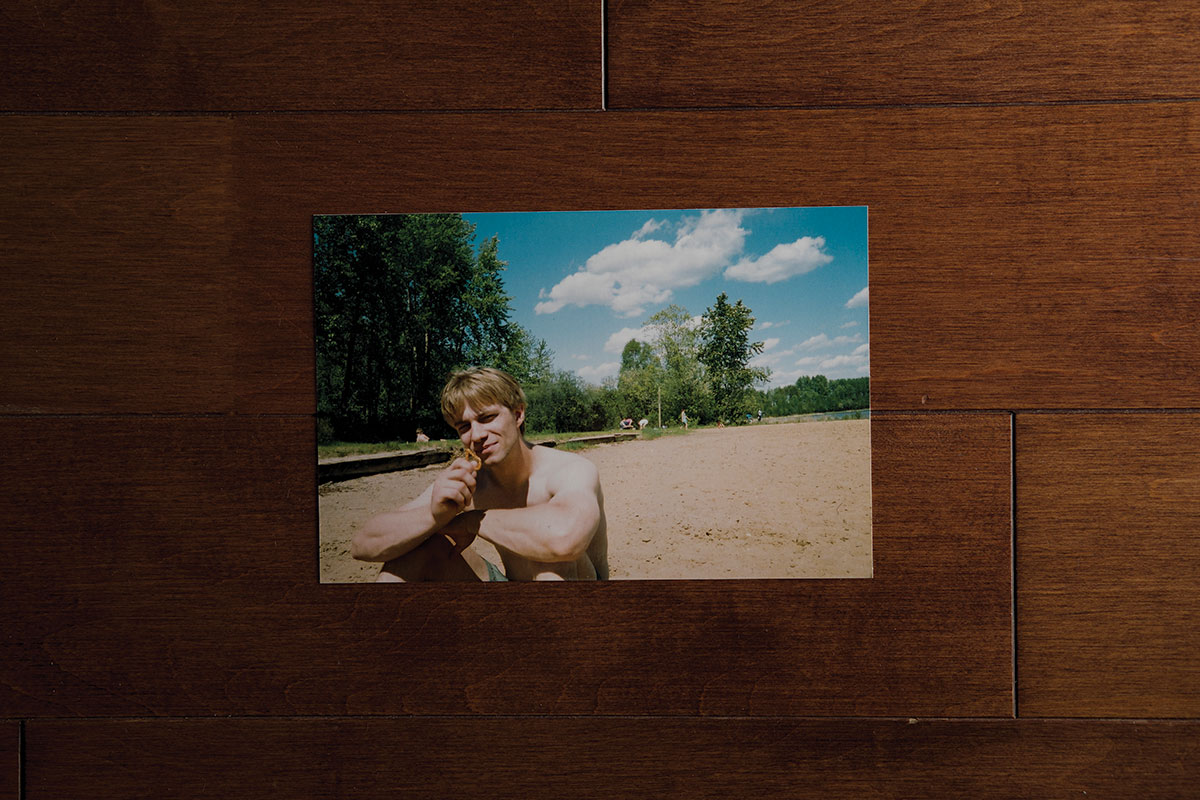Twenty seconds. Give or take.
Spencer Beach can’t say for sure just how long he was on fire.
Long enough to stumble to two exits—twice—and yank on door handles that wouldn’t budge.
The flash fire that engulfed him in an Edmonton home was sucking in all the oxygen, creating a vacuum that sealed him inside. A flooring installer by trade, he had been removing linoleum in the laundry room—a rush job since the manufacturer mislabelled the boxes and the contractor didn’t want to incur penalties for a delay. Beach and the rest of the crew were often told to use their boss’ homemade shortcut: douse the flooring in a contact thinner to reactivate the glue. That way, you could just peel it off.
He was on his hands and knees when he first heard a whistle as loud as a thousand kettles, followed by a boom as the furnace set the fumes alight.
Now the skin on his face felt like it was shrinking. His lips, like they’d been swarmed by bees.
“The heat was inside of me. It wasn’t like any burn you’ve ever felt,” Beach says. “It was everywhere.”
With no way out, he curled up on the floor, interlocking his fingers behind his head. His mind flashed to his wife, Tina, blonde and four months pregnant with their first child. He had just left her a voice message: the job was nearly done, he was the only one left, he’d be home soon. Tonight, he’d plan his buddy’s stag party.
Beach got to his feet and tried the door one more time.
In his right hand, Dr. Sarvesh Logsetty holds a pair of scissors. In his left, a piece of paper grabbed from the many stacks in his office at Winnipeg’s Health Sciences Centre (HSC), where he is head of the burn unit.
The surgeon is stumped.
He’s trying to remember the strategic cuts to make for a trick he would do as a kid. It’s a paper craft that turns a 4-by-5-inch sheet into an open shape large enough to walk through.
“What am I doing wrong?”
Logsetty wants to use the analogy to explain the skin graft meshing techniques he routinely does for patients who’ve suffered severe burns to large swaths of their body. The techniques also use strategic cuts—to expand pieces of skin up to nine times their original size.
Every centimetre counts in these life-saving reconstructive surgeries where patches of unharmed skin are removed from one site to cover another, explains the University of Manitoba professor of surgery and psychiatry.
“Ta da,” he says, holding up the large paper circle. “Damn, that was driving me insane.”
![Dr. Sarvesh Logsetty's curiosity about suturing goes back to age four, to Hyderabad, India, where he would hang around the medical clinic run by his great-aunt // PHOTO BY DAVID LIPNOWSKI [BA(HONS)/08]](/wp-content/uploads/2019/11/feature-after-the-fire-doctor.jpg)
Dr. Sarvesh Logsetty's curiosity about suturing goes back to age four, to Hyderabad, India, where he would hang around the medical clinic run by his great-aunt // PHOTO BY DAVID LIPNOWSKI [BA(HONS)/08]
Finding solutions is what the 51-year-old has spent decades doing, to alleviate pain and hardship for burn patients. “Each one of my research projects,” he says, “reflects a patient’s journey.”
Logsetty knows Beach’s well, having operated on him more than a dozen times. He was working the day Beach was rushed to University of Alberta Hospital. The surgeon remembers how this 29-year-old—with burns to more than 90 per cent of his body—was more worried about how others would handle the news than he was his own chances for survival (about five per cent).
“Even afterwards, he’s always thought about how he can help other people and how he can use his experience to help them get through,” says Logsetty, who brought his expertise to UM in 2007.
One person’s recovery involves a slew of professionals.
Beyond nurses to do dressing changes, there are dietitians, physiotherapists, occupational therapists, psychologists, psychiatrists and social workers. On the burn ward at HSC, the team includes UM students across disciplines. The unit admits 100 to 200 patients a year, and treats another 250 to 400 (including cases of frostbite and flesh-eating disease). About 40 per cent of patients are children. Among the adults, the majority are men, who tend to engage in riskier behaviour than women, Logsetty notes.
When compared to other health conditions, there’s an added layer. “With any burn, there’s a sense of guilt. Did I do something that caused this? Especially as a parent. That adds to the burden,” says Logsetty. “It’s different than something spontaneous like cancer, where it isn’t that they left the oil on the stove for too long or didn’t check the temperature when they put their child in the bathtub.”
Among 20- to 60-year-olds, burns are most often flame-related mishaps involving cooking oils catching fire, accelerants flashing back while burning grass, or house fires erupting in the night, Logsetty says. Burns from scalding are most common in kids and the elderly.
His research probes what social determinants increase your chances. A study released with UM psychiatrist Dr. Jitender Sareen [MD/95, BSc(Med)/95] last year showed people with a low income were as much as five times more likely to suffer burns. And the researchers mapped high-incidence areas in Winnipeg for policymakers to target prevention strategies.
“With any burn, there’s a sense of guilt. Did I do something that caused this? Especially as a parent. That adds to the burden.”
Logsetty offers a window into the daily challenges on the burn unit. Within its dual-chamber isolation rooms, there’s an ongoing battle against infection, down to the microscopic fibres of hospital curtains that may harbour antibiotic-resistant bacteria.
Burn patients face a far greater risk because their injuries aren’t straightforward open wounds. There’s dead skin sitting there, providing a perfect food source for bacteria. And because the skin is dead, there’s no link to the body’s blood. No trigger to get infection-fighting white blood cells to activate and defend. “So the bacteria can happily grow, getting stronger,” says Logsetty. “The risk of infection is really high.”
The seeping wounds are kept covered and clean. Peeling off the dressings can be excruciatingly painful and take hours. “No matter what we use, the dressings tend to stick,” says Logsetty. This agony is what drives him and UM collaborator Song Liu, a medical microbiology and infectious diseases researcher, also in the Rady Faculty of Health Sciences, in their efforts to reinvent the burn bandage.
Together, they’re developing not only a less sticky coating but a dressing they hope will transform burn care. They’re designing a fabric to detect infection, alert medical staff by changing colour, and then release antibiotics from within—all without having to remove it, Logsetty says.
Different colours would indicate different bugs. If the spot of colour were to grow bigger, it would tell nurses the infection wasn’t getting any better. The bandage will be made of nanofibres, or straw-like chemical structures that break down when they come into contact with bacterial enzymes. The centres will be filled with either a liquid to release dye or a liquid containing the antibiotic. A bandage that both diagnoses and treats infection would be a first in the field. Logsetty says they could have a tangible product in as little as five years.
Liu also holds a patent for an antibiotic-resistant fabric, which could one day mean self-cleaning hospital curtains. He bonded a chlorine-like chemical to the curtain that kills bacteria on contact, one that not only won’t wash out in the laundry but is reactivated by water. One of Logsetty’s recent studies showed that, within two weeks of being washed, five out of eight untreated hospital curtains tested positive for antibiotic-resistant MRSA.
PHOTOS BY AMBER BRACKEN
Leather hiking boots. Leather knee pads. A leather work belt. Beach didn’t think twice about the gear he put on the morning of Aug. 24, 2003. (But he did contemplate calling in sick—just a feeling that he should, but one he ignored.)
The leather is what saved the less than 10 per cent of Beach’s body surface that wasn’t burned. His feet below the ankles. A patch in the middle of each knee. His waistline.
“There’s a line around my waist where you could see where my belt was,” he says.
Only once the vapours and air pressure subsided in the home was he able to open the door to the garage and escape. A neighbour then came running with a hose.
Since that day, Beach has undergone 38 surgeries.
His burns reveal the most severe form: third- and fourth-degree, which tear through the epidermis and dermis and extend into the muscle, fat and bones. At first, these sites (that appear white or charred-black) are the least painful for patients, since the flames have destroyed the nerve endings.
While lesser burns can heal on their own—as cells lining our sweat ducts and hair follicles automatically spread out to rebuild—severe burns require grafting.
Skin from Beach’s feet is now on his face. As is skin from his knees and hip. Pieces of his foreskin form his delicate, upper eyelids while skin from his scrotum shapes his lower.
Logsetty can use meshing instruments that stretch and expand what small percentage of skin survives—the graphs look like criss-crossed grids, almost translucent—but each time he does, the skin gets thinner, leaving more room for scar tissue to fill in the gaps. It’s the scarring that leads to chronic pain.
“[With Beach] I had to take three per cent and expand it into more than 90 per cent, somehow or another,” says Logsetty. The key to advancing burn care, he says, is to develop ways to grow better skin.
Beach received synthetic skin, as well as skin from cadavers, before new skin was cultured from his own cells. With Logsetty at the helm, Beach became the first—and is still the only—Canadian to receive a unique, double-layer skin that’s more resilient than anything that’s come before. A sample of his skin, the size of a business card, was cultured in a lab in Cincinnati, OH, and then multiplied time and time again to eventually cover nearly half his body.
Experimental in the early 2000s, the technique is still innovative today, says Logsetty, but not yet widely available because the company has faced hurdles bringing it to market. “From an overall standards of burn care, it’s a gamechanger,” he says.
“[With Beach] I had to take three per cent and expand it into more than 90 per cent, somehow or another.”
Even though there are still improvements to make—the skin doesn’t contain pigment, hair follicles or sweat ducts (so on a hot summer day, Beach has to watch for heat stroke)—it means less scarring and greater quality of life, says Logsetty.
He’s also in the process of developing a research project at UM that will explore new ways to use stem cells to create skin, and is collaborating with a Quebec company, Loex, on a similarly robust skin alternative.
Skin-grafting surgeries can be marathons of endurance and difficulty. An intensive operation can take 12 hours, but shorter is best since patients are already so unstable going in. The temperature of the room is kept at 29.9°C to prevent patients from becoming hypothermic. Their whole body is exposed on the table—in order to graft different areas—and without skin, they’re without a key organ that helps regulate body temperature. When our temperature drops, we bleed more, so there’s also a greater risk of bleeding out on the table. Disposable warming blankets, inflated with warm air, help retain heat.
In the stifling environment, Logsetty and the team wear surgical gowns made of Gortex or other waterproof fabrics. (One of his research projects studies the effects on the medical team, including how much weight they lose from sweat during a procedure.)
On this ward, named after Manitoba firefighters, the mortality rate is less than three per cent, on par with the top burn centres across North America, notes Logsetty. Not many of their patients are firefighters nowadays, given how safety training and gear have evolved. “But unfortunately, when they do become injured,” he says, “it’s usually devastating.”
Nine months after the fire, Beach rolled over for the first time. He had lost 63 pounds and at six-foot-two was down to 112. The scar tissue had built up on his ligaments and tendons, and his muscles were wasting away with atrophy. The movement was small but it felt like a big win that came just in time. After the fire, he was angry, depressed, suicidal; now he wanted to see what else he could do for himself.
With progress comes greater survival rates, which mean more people living with the long-term consequences of burn injuries like disability, financial problems and chronic pain. Trauma survivors are at least four times more likely to take their own life, Logsetty and Sareen revealed in a 2014 study. They’ve since discovered they’re also twice as likely to have depression, anxiety or substance-abuse issues.
Logsetty says patients often tell him they don’t want to go on. He helps them reintegrate with the life they once had, as much as possible. “It’s not, I fixed your hernia, your sutures are out, you can call me if you have a problem. There is a continuity of care we don’t see in most other surgery.”
That’s why he’s made this his life’s work. One patient describes Logsetty as “the most caring and considerate doctor I have ever met;” another says he “created a place of love in the burn unit.”
The only burn expert between Edmonton and Toronto, he makes himself available 24-7 to residents and nurses, even when not officially on call. “The standard of care I try to hold myself to—and teach my students—is What would you expect for you or your loved one?” says the father of two kids (under age seven), and husband to epidemiologist Rae Spiwak [BA(Adv)/00, MSc/04, PhD/17], who also studies mental-health issues in trauma patients. “The biggest thing I’ve learned is that life can change in an instant.”
This summer, Logsetty spoke at Winnipeg’s inaugural Face Equality Awareness event for people living with facial differences. “It’s important,” he adds, “to help people understand that, although the outside of somebody might have changed, the inside is still the same—part of what our team does really well is help burn survivors come to that understanding themselves.”
It was Beach’s wife who held up the mirror for him the first time, only once he’d consulted with a psychologist. He couldn’t bring himself to look beyond his nose, with its missing lobes and exposed bridge. Gone was the dimpled grin of a guy who was always the life of the party.
“The standard of care I try to hold myself to—and teach my students—is What would you expect for you or your loved one?”
Now, if kids stare at the grocery store, he’ll engage with a smile and a wave. Often, they think he’s just really old—a grandpa, not a father, to his kids, he says. When adults approach, which he’s totally fine with, it’s always the same question: Can I ask what happened?
Beach doesn’t have photos of what he used to look like up in his house, only because “they’re not picture people.” And no longer does he appear as his former self in his dreams.
“I’m extremely proud of who I am,” Beach says.
He’s a motivational speaker who finds fulfillment in trying to create positive change in the workplace—who’s spoken to Winnipeg workers about putting safety before money and supervisors’ demands. But his life isn’t without ongoing challenges.
He has nerve damage and reduced mobility in his joints.
(He says he has the equivalent of seven-and-a-half fingers, since doctors had to amputate portions, up until they found blood flow.) And with some stubborn wounds that won’t heal, he regularly gets blood infections—20 in the last 10 years. Nonetheless, he renovated his basement and next, he’ll build a fence.
“I’m extremely proud of who I am.”
With burn survivors like Beach, Logsetty notes, “The scar doesn’t define them. They define themselves.”
In a recent Facebook post, he signed off “one tough son-of-a Beach.”
“You want to be the person you used to be,” Beach says, “but now you have a different body to do it with.”
He returned—just once—to the site where it happened. Where a new house now stands.
“I had to see it.”
THE ADVOCATE
Early in his career‚ Dr. Sarvesh Logsetty saw how each burn unit across the country was labouring in its own bubble. “We have some very good burn centres across Canada—people are doing great work and research—but we didn’t really work together as a burn program in Canada‚ as a community.”
When he joined UM in 2007‚ he established the Advancement of Burn Care Network and made Winnipeg its base. And last year he launched the Canadian Burn Association and annual symposium‚ further connecting the multidisciplinary players in burn care‚ including firefighters and survivors‚ to learn what’s working‚ what’s not and what to try next.
He says research in burn treatments is grossly underfunded‚ since there are fewer “champions” for the cause. “We’re still at the infancy of really understanding wound healing‚” says Logsetty‚ “how to improve it‚ how to avoid scars where we can‚ and how we can make them better.”
While the frequency of burns has dropped dramatically since the 1960s—with greater safety awareness‚ smoke detectors and legislation to safeguard water heaters—trauma as a whole is still the leading cause of death in Canadians 40 and under. “It costs the system more money than just about any other health-care problem that’s out there, yet we barely hear about traumatic injury‚” says Logsetty‚ who‚ as a general surgeon‚ is also tasked with removing knives from abdomens after weekend violence, or bowels burst in car collisions. In the last week alone‚ he’s removed two spleens ruptured in crashes.
“What frustrates me‚ from an academic perspective‚ is that trauma doesn’t have a home. There is no institute for trauma—it gets lumped in under muscoskeletal health and arthritis. That means, in terms of resources, we’re struggling with identification of the importance of trauma‚ and struggling with helping people understand why we do the research we do‚ and how it affects the people that it affects.”










